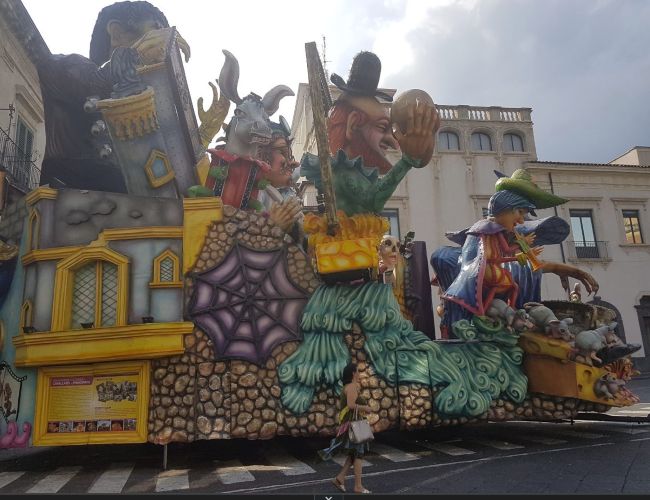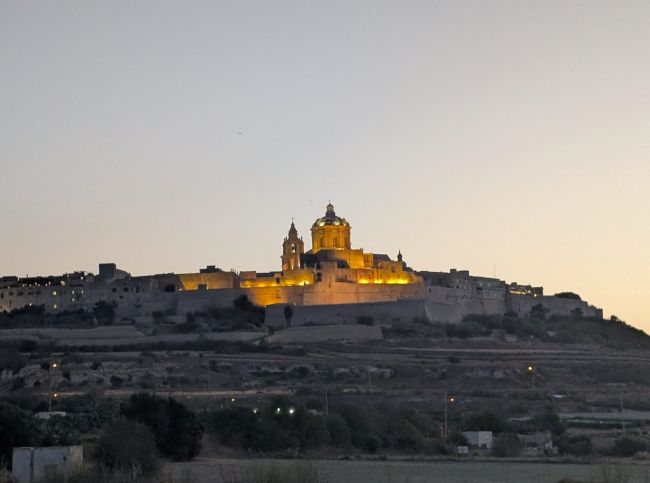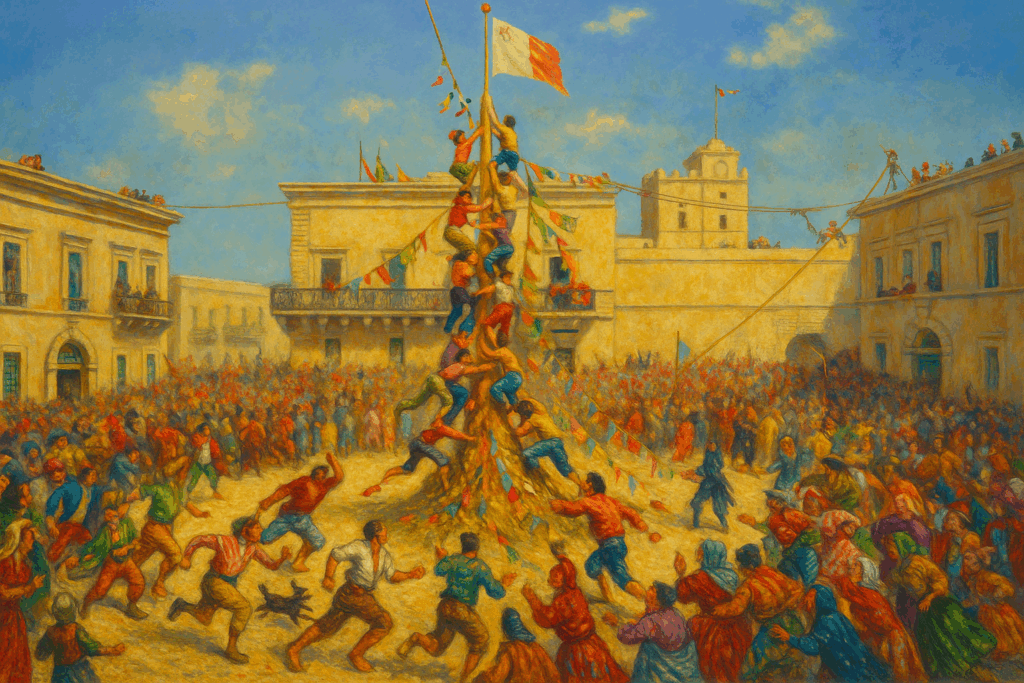| Malta Short Let: Cozy Stay in Gzira | |
|
Sliema Area Modern Designer Finished 2 Bedrooms + Games Room. First floor with Maltese Balcony Large back Terrace with swinging sofa Fully Airconditioned + Full Kitchen 3 TVs, including 65” with backlight. |
 |
|
Book Now: Google Travel | Direct (Cheapest) | Booking.com | Airbnb |
|
What to Wear for a Winter Travel Escape
Picture yourself strolling Valletta’s golden streets under crisp Mediterranean winter skies, with vibrant Carnival parades in the distance and fewer crowds to share the view.
Planning a Malta in February trip? You’re in for a unique winter escape, but the weather can shift from sunny to stormy in a flash—locals often note that two sunny days bring a third with a storm. This guide, updated as of October 23, 2025, breaks down February’s weather in Malta and offers a practical packing list to keep you comfortable and stylish, whether you’re hiking Gozo’s lush trails or joining the festive Carnival.
Stay in the heart of the action with our Gzira Airbnb, perfect for exploring nearby Valletta and Sliema’s scenic promenade. We’ve gathered insights from travelers and locals to ensure you’re ready for your Mediterranean winter adventure.
Check the winter 2024-2025 flight schedule and flight booking tips to plan your journey.

Key Takeaways
- Layering is your best friend: Malta’s weather shifts daily, so pack T-shirts, sweaters, and a waterproof jacket.
- Waterproof shoes are essential: Hiking boots or sneakers handle wet streets and muddy trails.
- Bring Carnival flair: A costume, A mask or water pistol adds fun to festive parades.
- Check for heating: Older rentals may feel damp—confirm heaters or dehumidifiers.
- Umbrella, Sun Screen, Bathing Suit
Table of Contents
- February Weather in Malta 🌦️
- Microclimates & Local Wisdom 🌍
- What to Pack for Malta in February 🧳
- What to Wear: Day vs. Evening 👗
- Practical Travel Tips 💡
- Local February Comfort Hacks ☕
- FAQs: Malta in February ❓
February Weather in Malta 🌦️
February in Malta is the heart of winter, but it’s mild compared to Northern Europe. For visitors from colder climates like the UK, it feels like a balmy escape, with daytime highs typically 13–17°C (55–63°F), occasionally reaching 18°C (64°F) in rare warm spells. Locals, however, bundle up, noting: “What’s cold for us feels warm to you.” Below is a quick overview of February’s weather, including regional and weekly variations, to help you pack smartly. [Placeholder: Image of Malta’s coastline with a mix of sun and clouds]
| Week/Region | Temperature (°C/°F) | Rainfall | Wind Speed | Quick Tip |
|---|---|---|---|---|
| Early Feb (Coastal: Valletta, Sliema) | 12–16°C (54–61°F) | ~22 mm, 3–4 rainy days | Breezy, 15–25 km/h | Waterproof jacket for coastal winds 🌊 |
| Early Feb (Inland: Mdina, Mgarr) | 13–17°C (55–63°F) | ~20 mm, 3 rainy days | Light breeze, 10–20 km/h | Lighter layers for warmer inland days ☀️ |
| Mid Feb (Coastal: Valletta, Sliema) | 12–17°C (54–63°F) | ~21 mm, 3 rainy days | Breezy, 15–20 km/h | Pack a carnival costume for Feb 19th festivities 🎭 |
| Mid Feb (Inland: Mdina, Mgarr) | 13–17°C (55–63°F) | ~20 mm, 2–3 rainy days | Light breeze, 10–15 km/h | T-shirt for sunny afternoons 🌞 |
| Late Feb (Coastal: Valletta, Sliema) | 13–17°C (55–63°F) | ~20 mm, 2–3 rainy days | Breezy, 15–20 km/h | Hood over umbrella for windy showers ☂️ |
| Late Feb (Inland: Mdina, Mgarr) | 13–17°C (55–63°F) | ~18 mm, 2 rainy days | Light breeze, 10–15 km/h | Water pistol for Carnival fun 🎉 |
Key Notes: Expect 6–7 hours of sunshine daily and 11 hours of daylight (sunrise ~6:30–7:00 AM, sunset ~5:30–5:45 PM).
The sea temperature is chilly at 15–16°C (59–61°F), and rough surf or rip currents make swimming hazardous, even for strong swimmers.
Humidity (70–80%) makes it feel damp, especially in older buildings without heating. Travelers note rapid changes: “Had a hailstorm and flooding one minute, sun was back out half an hour later!” Rare storms with gusts over 50 km/h or hail may disrupt ferries or rural transport—check the Malta Met Office app for alerts.
For updates, visit Maltese Islands Weather. For more, see our comprehensive guide to Malta’s weather by month.

Microclimates & Local Wisdom 🌍
Despite Malta’s small size, microclimates make a difference. Coastal areas like Sliema and Valletta feel cooler due to sea breezes, often by 2–3°C, while inland are warmer and calmer. However not all of them, Rabat situated on a ridge tends to be cooler than other inland towns. In Valletta, you might see people sunbathing at Upper Barrakka one day and wrapped in scarves the next. We are knit picking here, if you come from Northern Europe Malta in February will feel like your summer!
Traditional limestone houses retain dampness and chill even on sunny days, with locals joking it feels colder indoors than out.
Modern hotels and Airbnbs often have heating or dehumidifiers, but older rentals may not—confirm with your host for a cozy stay.

What to Pack for Malta in February 🧳
Given Malta’s changeable February weather, layering is your best friend. Here’s a concise packing list for a 6-day trip, informed by traveler experiences and local advice, ensuring you’re ready for sunny afternoons, chilly evenings, muddy hikes, and festive Carnival fun:
Essential Outerwear
- Lightweight waterproof jacket or windbreaker (1): Essential for rain and wind, especially in coastal areas like Valletta.
- Light scarf or shawl (1): Adds warmth and style; doubles as a festive Carnival accessory.
Layering Staples
- Long-sleeve shirts (3): Great for layering; modest options for church visits (e.g., St. John’s Co-Cathedral).
- Warm sweaters or hoodies (2): Perfect for cooler mornings and evenings.
- Jeans or trousers (2): Comfortable for daytime; jeans are popular among travelers.
- T-shirts (3): For layering or warmer days, as one traveler noted: “I wished I packed more summer clothes!”
- Warm socks (5 pairs): Keep feet cozy in damp conditions.
- Thermal underwear (1–2 sets, optional): Useful for those sensitive to the damp chill.
- Sleepwear (2 sets): Warmer options for cooler nights.
Carnival Must-Haves
- Carnival costume or accessories (1 set): Pack a simple costume (e.g., colorful mask, hat, or themed scarf) for Carnival in Valletta or Nadur’s quirky parade—perfect for young and old!
- Water pistol (1–2, optional): Fun for Carnival’s playful vibe in Valletta or Nadur, great for kids and adults.
- Face Paint or Mask
Footwear
- Water-resistant hiking boots (1 pair): Ideal for muddy countryside trails or uneven streets, especially for wildflower hikes in Gozo or Dingli Cliffs.
- Comfortable walking shoes (1 pair): Waterproof or water-resistant sneakers with good grip for urban exploration.
- Casual shoes (1 pair): Smart, closed-toe shoes for evenings, preferably water-resistant.
Local Realities
- Travel plug voltage check (1): Malta uses Type G sockets at 230V; non-EU travelers should ensure hairdryers or straighteners are dual-voltage.
- Quick-dry clothing (2–3 pieces): Humidity means clothes dry slowly; pack quick-dry underwear or travel detergent for laundry.
- Anti-humidity pouches (2–3): Protect electronics like cameras or phones in damp coastal apartments.
Accessories
- Compact umbrella (1): Handy for showers, but a hood is better in wind.
- Sunglasses (1 pair): For bright days; UV index is 3–4.
- Sun hat or cap (1): Protects from sun during hikes or Carnival.
- Warm gloves (1 pair, optional): For chilly evenings, especially if sensitive to cold.
- Day backpack (1): For carrying essentials during tours or hikes.
Toiletries
- Travel-sized shampoo, conditioner, body wash, moisturizer, toothbrush, toothpaste, razor, personal hygiene products.
- Lip balm with SPF and moisturizer: Combat dry air and wind.
Electronics
- Mobile phone and charger (1 set).
- Camera (1, optional): For capturing scenery and Carnival moments.
- Portable power bank (1): Keeps devices charged during long days.
- Plug adapter (1): Malta uses Type G outlets.
Travel Documents
- Passport/ID, travel insurance, flight and hotel bookings, emergency contacts list.
Health & Safety
- Basic first aid kit, medications (including cold/flu remedies for damp weather), hand sanitizer, insect repellent for coastal areas.
- Zip-lock bags (3–5): Protect electronics or documents from rain or humidity.
Miscellaneous
- Reusable water bottle: Stay hydrated while exploring.
- Guidebook or maps: Helpful for navigating Malta’s sites.
- Travel pillow: For flight comfort.
- Snacks: For travel days or hikes.
- Headlamp or torch (1, optional): Useful for power outages during rare storms.
Tip: Travelers recommend the “onion look” (T-shirt, jacket, vest) for layering. For Carnival, a simple costume or festive accessories make you part of the vibrant celebrations—don’t forget a water pistol for playful fun! If renting an Airbnb, confirm it has a heater or dehumidifier, as dampness makes nights feel colder. See our Gzira Airbnb , for your ideal stay in the middle of it the action
What to Wear: Day vs. Evening 👗
Malta’s February weather varies daily, so plan outfits accordingly: [Placeholder: Image of a traveler in a layered outfit with hiking boots on a Gozo trail]
- Daytime 🌅: On clear days, wear a long-sleeve shirt, jeans or trousers, and a cardigan or light jacket. Water-resistant hiking boots or sneakers with grip are ideal for Valletta, Gozo’s muddy trails, or Dingli Cliffs. For warmer days (15–17°C), a T-shirt and jacket suffice, as one traveler noted: “I wished I packed more summer clothes!” For Carnival, add a colorful mask or themed scarf and a water pistol for festive fun.
- Evening 🌙: With dropping temperatures (8–12°C) and humidity, opt for a thick jacket or coat, warm trousers, and closed-toe smart shoes. A scarf or gloves help, as locals warn: “Dampness gets into your bones!” Thermal underwear is smart for chilly nights.
- Rainy Days ☂️: A waterproof jacket with hood beats an umbrella in wind, as cheap ones break. Waterproof shoes or hiking boots are a must for wet streets or muddy paths.
Tip: For Carnival or the Feast of St. Paul’s Shipwreck, dress warmly but festively with a costume or accessories . For churches like St. John’s Co-Cathedral, ensure modest attire (e.g., covered shoulders). Some cafés in Sliema offer blankets on outdoor terraces—perfect for February evenings. See our top activities in Malta for February.
Practical Travel Tips 💡
Check the Forecast: Monitor weather as your trip nears, as Malta’s conditions shift quickly. Use Maltese Islands Weather or the Malta Met Office app for reliable updates, especially for rare storms that may disrupt ferries or buses.
Accommodation in Gzira: Base yourself in Gzira for easy access to Valletta, Sliema, and the scenic Sliema promenade—perfect for February’s quieter vibe and evening strolls. Check our Gzira Airbnb guide for cozy, heated options, like a 2-bedroom apartment near Gzira Church with a seafront view.
Indoor Pool Option: For swimming, choose a hotel with a heated indoor pool, as sea swimming is hazardous due to rough surf and rip currents.
Footwear for Exploring: Water-resistant hiking boots or sneakers with grip are essential for uneven streets and muddy trails post-rain, as travelers advise: “Bring comfortable trainers/walking shoes.” Watch for slippery streets if you have mobility concerns.
Budget Travel: February’s off-season means cheaper flights and accommodations. Save more with our flight booking tips and winter flight schedule.
Transport Notes: Buses run year-round but may face delays in heavy rain. Ferries to Gozo or Comino can be suspended for days due to rough seas—check schedules in advance. Carry some cash (euros), as small cafés or Carnival vendors may not accept cards, especially during rare internet outages.
Cultural Events: Pack for Carnival or village feasts with a simple costume or accessories (e.g., mask, water pistol). Smart-casual attire works for upscale Valletta dining. Check if your Airbnb or hotel charges separately for heating—some older buildings use electric units with prepaid meters. Plan your days with our sample February itinerary.
Health & Allergies: High humidity and occasional scirocco dust or mold spores may affect those with allergies or asthma—pack allergy meds or an inhaler if needed.
Car Rental Caution: February roads can be slick with rain, and visibility drops in hail. Pack a small umbrella or microfibre towel to dry seats or bags if renting a car.
Stay Prepared: Bring a first aid kit, cold/flu remedies, and hand sanitizer for crowded events like Carnival. For safety, check our Malta safety guide.

Local February Comfort Hacks ☕
Want to stay as cozy as the locals? Try these quick comfort hacks: [Placeholder: Image of a cozy pastizzeria with steaming coffee and pastizzi]
- Warm up with a ħobż biż-żejt (Maltese tuna sandwich) or a steaming bowl of minestra—locals’ go-to winter comfort foods.
- Carry a folding tote bag—handy for market buys or Carnival accessories.
- Pop into a local bar or pastizzeria on rainy afternoons for a taste of Maltese winter life, or catch an indoor concert at venues like Valletta’s Teatru Manoel. Find cozy spots in our Malta winter cafés guide.
- Explore February’s lush greenery and wildflowers on a hike—trails like Dingli Cliffs or Gozo’s Ta’ Ċenċ are at their best now.
FAQs: Malta in February ❓
What is the weather like in Malta in February?
February is Malta’s coolest month, with daytime temperatures of 13–17°C (55–63°F), rarely reaching 18°C, and nighttime lows of 8–12°C (46–54°F). Expect 60–65 mm of rain over 8–12 days, often short showers, and breezy conditions (15–20 km/h). Sunny days offer 6–7 hours of sunshine.
What should I wear in Malta in February?
Layer with long-sleeve shirts, sweaters, jeans, and a waterproof jacket. Water-resistant hiking boots or sneakers are key for muddy trails or streets. For evenings, pack a thick jacket, scarf, and gloves if sensitive to cold. For Carnival, include a simple costume (e.g., mask, themed scarf) and water pistol. A hooded raincoat or umbrella is ideal for showers.
Can I swim in Malta in February?
The sea is cold at 15–16°C (59–61°F) and hazardous due to rough surf and rip currents. Hotels with heated indoor pools are a safer alternative.
How does February weather in Malta compare to other European countries?
Malta’s 13–17°C is milder than Austria (2°C/36°F), Germany (1°C/34°F), or Sweden (-13°C/9°F), similar to Spain (9°C/48°F) or Italy (8°C/46°F), but with higher humidity.
Is February a good time to visit Malta?
Yes, for fewer crowds, lower prices, and events like Carnival. It’s ideal for sightseeing and hiking, but not beach activities due to cold seas and unpredictable weather. See our Malta in February guide.
Does it snow in Malta in February?
No, Malta’s Mediterranean climate means no snow, only rain, hail, and cold temperatures.
What’s the humidity like in Malta in February?
High (70–80%), making indoor spaces feel damp and chilly. Modern accommodations often have heating or dehumidifiers; older rentals may not.
Are there any dress codes for February events in Malta?
Carnival and the Feast of St. Paul’s Shipwreck have no strict dress codes, but warm, festive attire (e.g., colorful scarves, masks, or simple costumes) and a water pistol add fun. Smart-casual is recommended for upscale Valletta dining. Modest clothing (e.g., covered shoulders) is required for churches.
Ready to experience Malta’s unique winter charm? Start planning your Mediterranean winter adventure today with our Gzira Airbnb and trip planning guide! [Placeholder: Image of a vibrant Carnival parade in Valletta]








